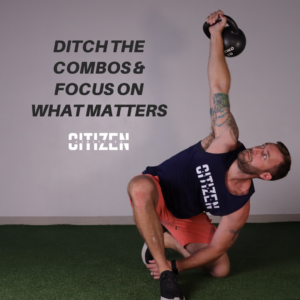Okay, do you guys remember the P90x days? You know… pumped up 90s jams, shirtless dudes with strangely-baggy shorts, and mid-workout motivation breaks? Ahhhhh, those were the days weren’t they??
Ehhh okay, yeah you got us. At Citizen Athletics, we’re never one’s to downplay or discredit those who are willing to put time and energy into their health and wellbeing. Fitness is amazing! And if y’all are getting down to Tony Horton and Jillian Michaels’ fitness routines, we won’t be the ones to stop you. But, there’s something else that these at-home workout moguls popularized. We hate to say it, but we almost wish it was just those damn baggy shorts 😂.

Combination exercises, like a lunge-curl-squat-and-press have become routinely implemented by fitness professionals and daily gym-goers alike. All in the name of ‘getting a good full body workout’ (whatever that means), many of us have been duped to believe that adding unrelated exercises together gives us that extra edge to take our performance to the next level. It’s even popularized in the pro sports setting! Off season Instagram posts are riddled with medicine ball sequences and burpee derivatives that could make Will Hunting forget what’s next.
Okay, so why does this feel like it’s the beginning of a bubble bursting party? Well… We’ve got some bad news for y’all.
Most combination exercises are vastly underloaded and often have large limitations, or bottlenecks, in their never ending sequences.
CONSIDER YOUR BUBBLE BURSTED
Let’s take the all too popularized Lunge + Curl for example and ask ourselves: ‘Can I curl the same amount of weight that I can do lunges with?’ If the answer is yes, you should probably start lunging more… and maybe grab a pair of Tony Horton’s baggy shorts to cover those chicken legs while you’re at it. For everyone else, we can start to see where the ‘bottlenecks’ are forming.
Combination exercises rarely stimulate your body enough to induce strength, size, or power adaptations because there’s often a mismatch of load. Feel the arms starting to burn after a few reps of the Lunge Curls? You’ve probably got another 30 in the tank before your legs get there…

Here’s the deal. It’s not the fact that we think all combination exercises are bad or under loaded, but it is all about the implementation of how you use them. If you ask us, determining ‘good’ versus ‘bad’ combination exercises boil down to answering a few simple questions:
What Does the Exercise Accomplish?
As S&C Coaches and Physios, we know the importance of having an intention behind the exercises we select. When it comes to resistance training, we often select exercises that have the intent of producing specific adaptations like muscular strength, muscular power, or some sort of muscular size/hypertrophy. The ‘perfect exercise’ that checks off hypertrophy, strength, power, and speed doesn’t exist. Instead, lets make sure that we’re being specific with the exercises we select to really get the most bang for buck/
We all know deep down that those P90x Lunge-Punches just aren’t doing it for you. What they really do is provide a ‘non-specific’ effect to the body – the more limbs you move around, the more energy it requires and the increased demand the exercise has – this might be great if you’re looking to increase calories burned in a short amount of time, but bad for making consistent gains in the gym.
WHAT IS THE INDIVIDUAL DIFFICULTY OF EACH EXERCISE?
This one may be a tough pill to swallow… But, if both exercises are easy in isolation, then putting them together is just going to make you fatigued and sore from exercises that are… well… easy. That means those squat-curls, or lunge-presses probably are just making you excessively fatigued, without the benefit of performing a truly challenging exercise.
However, the converse is true too – combining two difficult exercises into one may make you too fatigued to perform the subsequent exercises to any degree of efficiency. What we need is to find the sweet spot.
IS THERE A SPECIFIC BENEFIT TO PERFORMING THE EXERCISES TOGETHER?
Just like the bottleneck issue we discussed earlier, we need to discern whether there is a specific benefit to adding both of these exercises together. But, before we delve further, let’s talk about what we mean by ‘specific.’
Believe it or not, strength & power can be seen as ‘skills.’ This is because most often ‘strength’ is task-specific; meaning the strength gains you get from an exercise will certainly help you with increasing the weight you can do in that exercise, but don’t readily transfer to others in the way we might think. This would mean that there is a ‘specific’ benefit to adding two exercises together if the numbers / weights you use during that exercise is meaningful for you to improve over time.
PSA: Cardio is largely non-specific, and therefore combining exercises because you want to ‘increase your heart rate’ isn’t a specific effect.
HOW BIG IS THE LIMITING GAP?
Okay, so you’re probably pretty likely to be able to squat more than you lunge, but how big of a gap is there? Is that a bigger or smaller gap than if you did a lunge and a curl? The closer your maximum tolerable resistance for two exercises is, the less likely the exercise will be underloaded. AKA – Make sure the bottleneck is as little of a factor as possible.
Combining exercises of similar difficulty is key to making sure that you’re not blatantly under loading or over loading a movement pattern consistently.

LETS USE AN EXAMPLE
Okay, now that we’ve got that off our chest, let’s dive into what combination exercises we actually like to prescribe, and more importantly, if they stand up to the ‘Bottleneck Questionnaire.’
Let’s start with the Barbell Clean & Jerk:

WHAT DOES THE EXERCISE ACCOMPLISH?
The Clean & Jerk aims to accomplish improving total body strength and power due to its heavy load, requirements of speed, and specific technical demands. They are often implemented in people who want to get better at the sport of weightlifting, or aim to improve the qualities of speed and power in (often contact) sports.
WHAT IS THE INDIVIDUAL DIFFICULTY OF EACH MOVEMENT?
Both exercises can be adjusted to maximal difficulty, such as a 1 Rep Max, AND reduced down to lighter weights for improved technical efficiency. Often, both exercises appear nearly equal in difficulty, but it often is distilled down into individual factors of training history, muscular development and technical prowess of the movements.
IS THERE A SPECIFIC BENEFIT TO PERFORMING THEM TOGETHER?
YES. Clean and Jerk is part of the sport of Olympic Weightlifting. Not performing them together is like practicing a basketball shot without jumping, and then practicing jumping without shooting a basketball. It’s a JUMP SHOT, just like it’s a CLEAN AND JERK. Occasionally, individuals will practice each movement in isolation to focus their energy on the task at hand, but it is always with the intent to improve their numbers with the C&J.
HOW BIG IS THE RATE-LIMITING GAP?
Smalllll. The limitation in the Clean and Jerk is rarely due to absolute strength, but rather, a technique or fatigue limiter at maximal output. Many people can individually clean higher than their C&J, and jerk higher than it as well, but the difference is often minor and is rarely due to massive limitations in one of the two lifts.
Bringing it Home:
Combination exercises aren’t inherently ‘bad’ exercises. BUT, if you’re aimlessly plugging away on your multi-step combination drills and aren’t noticing much change in the gym, you may want to dial the variability back, and focus on one thing at a time.
Use this questionnaire and our decision-making tree to see if you’re making the right call with the exercises YOU choose to combine.
If you’re struggling with managing your own programming, or want more ‘deep dive’ content like this, the Citizen Athletics app is the perfect entry point into science-backed training from trusted Physical Therapists & Coaches with years of education & experience in the field; all at your fingertips.
Click here to get started today!
ABOUT THE AUTHOR:

Dylan Carmody is a Doctor of Physical Therapy, and Strength & Conditioning Coach with 5+ years in the performance and rehab industries.
Having dabbled in training modalities like Olympic Lifting, Cycling, Powerlifting, and CrossFit, Dylan has a deep appreciationfor all things performance, while still having a positive and fun-loving approach to exercise.
Dylan’s coaching experience is equally eclectic, ranging from performance coaching for elite athletes in the NCAA D1 setting, to group fitness and weight loss coaching in his early career.
With detailed exercise programming & consistent communication, he aims to create a training environment that is not only ‘tolerable’ for clients’ aches and pains, but truly helps to resolve their issues in the first place.

